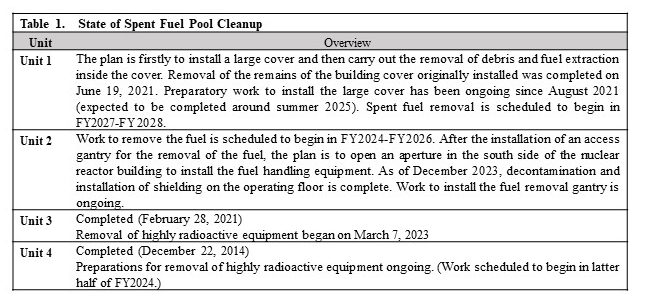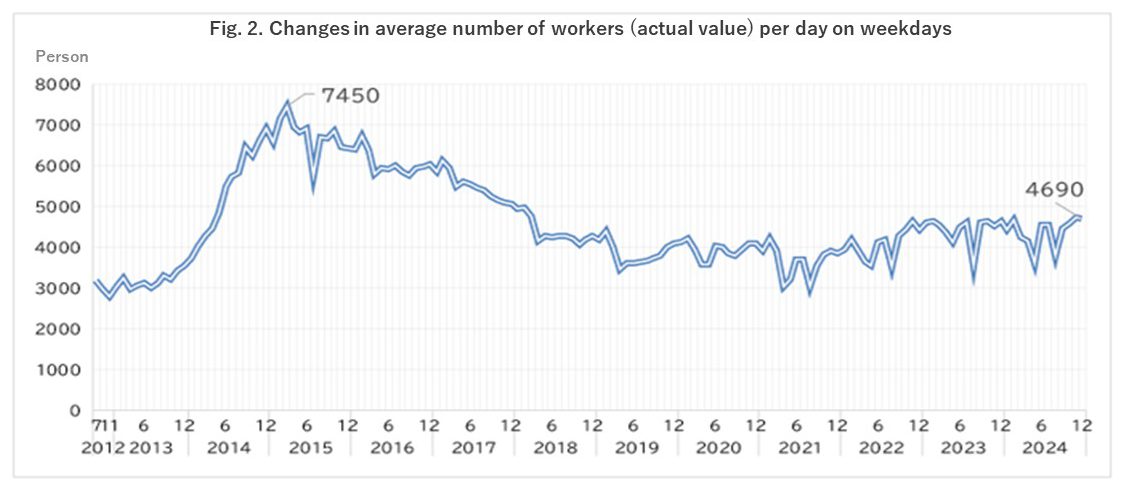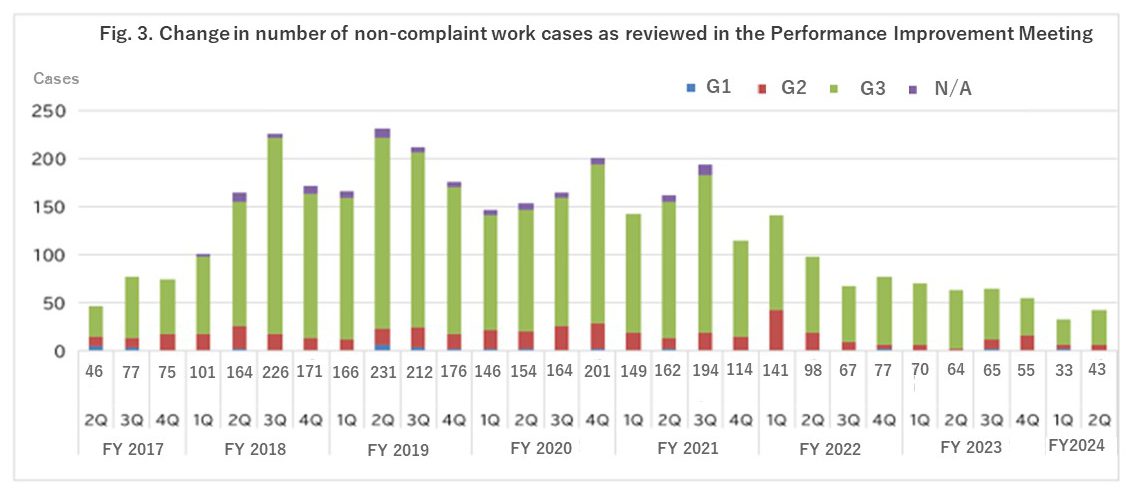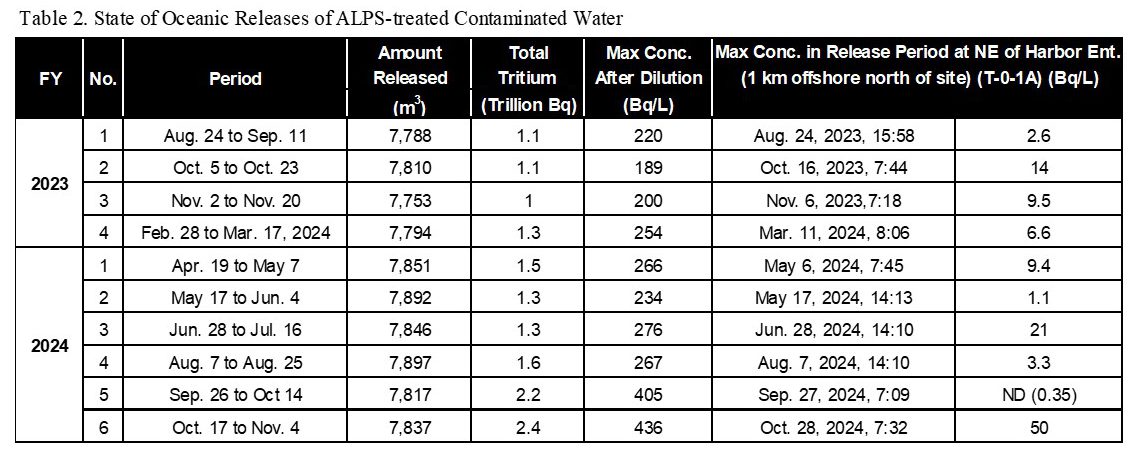Fukushima Now (28) – Current State of Post-Accident Operations at Fukushima Daiichi Nuclear Power Station (August 2024 to January 2025)
By Matsukubo Hajime
State of the Plant
The water temperature in the containment vessels and the spent fuel pools (SFPs) shows no great variation despite seasonal temperature changes. The state of releases of Xenon-135 (half-life roughly nine hours), released when uranium fuel undergoes fission, is also unchanged and it can therefore be estimated that the state of the reactors is stable. Further, around 20,000 becquerels per hour (Bq/h) of radioactive materials were being released to the atmosphere from the buildings (TEPCO assessment in December 2024, Fig.1).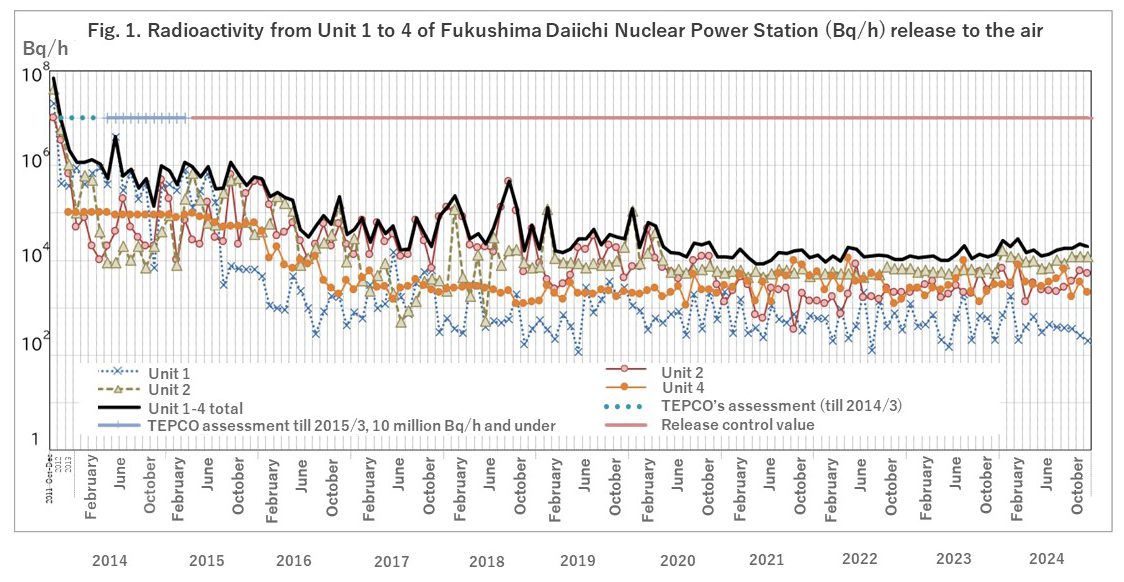
At the same time, decay heat has fallen greatly with the passage of time, and thus the volume of cooling water injected into the reactors has been reduced (falling from 7-10m3 per hour in May 2011 to 1.4-3.8m3 per hour as of January 2025). In particular, the water level in the doughnut-shaped suppression chamber (S/C) under the pressure containment vessel in Unit 1 is high. As there is a concern about damage from earthquake tremors, the amount of water injected into the S/C has been reduced in stages since March 2024 (3.7m3/h in February 2024 to 1.4 m3/h in January 2025). The water level before the reduction in injected water was around 8.5m from the bottom of the S/C, and this has now gone down to about 6.6m. As the bottom of the drywell (D/W), a flask-shaped object in the upper part of the pressure containment vessel, has around 1m of deposited material (debris, etc.) from pre-accident times and it is estimated that the upper part of the deposited material is about 7.5m above the bottom of the S/C, it is thought that the deposited material is exposed above the surface of the water. However, the temperature at the bottom of the reactor pressure vessel is declining from its peak in late September. Further, water is leaking from the S/C toward the side of the reactor building. This leakage was first estimated to be of the order of 0.02m3/h, but has been increasing (being roughly 0.07m3/h from about December 31, 2024 and roughly 0.13m3/h from about January 15, 2025).
The state of removal of spent nuclear fuel from the SFPs is summarized in Table 1. Spent nuclear fuel removal from Units 3 and 4 has been completed. Preparations are now being made to remove the spent nuclear fuel from Units 1 and 2.
The delayed experimental removal of fuel debris was completed on November 7, 2024. (Details can be seen in the article by Ms. Sakurai Megumu in this edition.) With the start of this work at 07:20 on September 10 (the time at which the front tip of the telescopic-type removal device passed through the isolation valve of the connecting structure of the X-6 penetration) the mid- and long-term roadmap moved on to “Stage 3,” the period from the initiation of removal of fuel debris to the completion of decommissioning measures.
Changes in the average number of workers onsite per day is shown in Fig. 2. As of December 2024, the number of workers was 4,690. The number of reports of non-compliant work cases is trending downwards.
State of Contaminated Water
Contaminated water countermeasures at Fukushima Daiichi Nuclear Power Station (FDNPS) can be broadly divided into three areas: 1) Reduction of groundwater flowing into buildings, 2) Reduction of contaminated water flowing into the sea, and 3) Reduction of the toxicity of contaminated water. Countermeasures implemented to reduce water inflow into the buildings are, from higher elevations downward, (A) Pumping up groundwater at the groundwater bypass and releasing it into the sea (953,611m3 up to February 10, 2025), B) Installation of a frozen earth barrier (on-land water barrier, total length roughly 1,500m) surrounding FDNPS Units 1-4, C) Pumping up water at the subdrains and releasing it into the sea (1,801,404m3 up to February 9), and D) Paving of the site with asphalt to suppress permeation of rainwater into the soil. Measures to prevent the discharge of contaminated water into the ocean include A) Groundwater leakage prevention by a steel water barrier on the sea-side and B) Pumping up of groundwater dammed up behind the sea-side water barrier from the well points and groundwater drains. Due to these measures, the volume of contaminated water discharged, 540m3/day in May 2014, fell to 80m3/day in FY2023, and was below 100m3/day in FY2024.
In the reduction of the toxicity of contaminated water, cesium and strontium are removed, and after the removal of impurities using a reverse osmosis (RO) membrane, the multi-radionuclide removal equipment (ALPS – Advanced Liquid Processing System) then removes 62 radionuclides. The water is then stored in tanks (containing 1,297,190m3 as of January 30, 2025. However, due to past equipment malfunctions and operational policies, around 64% of the stored water exceeds the notification concentration). Oceanic release of the ALPS-treated contaminated water began on August 24, 2023, a total of 78,285m3 being released in ten batches by January 2025. Table 2 shows the amounts released in each release and the total amount of tritium released. The concentration is gradually rising. One further release is scheduled during FY2024. In addition, roughly 15,720m3 of water remain in buildings, and a further 8,946m3 of strontium-treated water, etc., 5,644m3 of water treated by RO, and 9,463m3 of concentrated wastewater, etc. also exist onsite.
Further, the number of Unit 1-4 storage tanks containing ALPS-treated water, strontium-treated water, and other water was 1,083 as of January 23, 2025. Work to dismantle the 12 tanks in the J9 area is due to begin in FY2024. Since November 6, of the horizontal tanks (367 units in temporary storage onsite) used at the time of the accident, 28 unused tanks whose interior is not contaminated are being decontaminated and dismantled.
